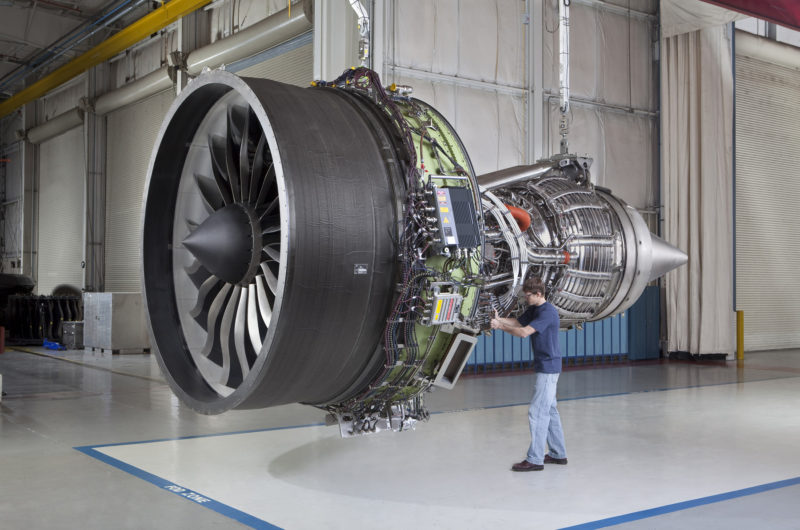
A major corporation invests in Rutland.
This piece first appeared in The Rutland Business Journal.
General Electric (GE) Aviation’s airfoil manufacturing plant in Rutland outlasted the long-toothed 2008 recession with dogged attention to cost and efficiency. It’s not just its high productivity, though, that positions Rutland as a vital element in GE’s supply chain. The plant’s leading-edge production methods and skilled workforce drive a continuous process to hone existing competencies and develop new areas of expertise, according to plant manager Dan DiBattista. As a result, “there’s a lot of faith in this site,” he says of Rutland’s 500,000 square feet of manufacturing. Despite the economic downturn, GE invested about $100 million in the plant in the last few years, and DiBattista expects that they’ll put in another $20 million annually for the next couple.
GE has long been in the business of building engines for airplanes; the company began supplying the military during World War I, and entered the commercial market in the 1970s. Last year, sales of aviation products and services, including engines, generated over $17 billion in revenues for the company.
The airfoils produced in Rutland are the jet engine’s unheralded workhorses. In the engine’s front section, a line of disks rimmed with the high performance blades spins at breakneck speed, acting as an uber fan that pushes and squeezes incoming air to a compression of up to 40 times atmospheric pressure. When that compacted air is mixed with fuel and ignited, it creates a force so enormous that two 13,000 pound engines can produce enough thrust to lift a 500,000 pound wide body aircraft. In the back part of the engine, airfoil-edged disks provide the brawn that keeps the engine going; they spin from the force of the engine’s own exhaust, and via a shaft, transfer their rotation back to the front end, self-perpetuating the entire propulsion cycle.
The Rutland plant has been around since the 1950’s. Today it supplies parts to GE’s engine assembly plants, and spares to distribution centers. Its airfoils and vanes, other blades which direct air flow, are used in the engines of regional and wide body commercial planes, helicopters, and military transports and fighters.
DiBattista spent 26 years at GE’s Lynn, Massachusetts engine assembly plant before taking the helm in Rutland about 18 months ago. “There’s a lot here,” he says of the operation, “in the technology of the forming processes and the metalurgy. The material properties in these blades are extremely important both for safety and for the [durability] of the parts.” The plant’s vertically integrated method of manufacturing many of their established blade types is a source of competitive advantage, he adds.
Rutland starts with long bars of metal, which it cuts, treats, heats and extrudes. A series of compressive forging processes form the pieces into blades, which are finished with drilling, grinding and other machining operations. “Being able to take in raw stock and turn it into forgings keeps us very flexible,” says DiBattista, “forming material is a business that a lot of [machining houses] don’t do and don’t understand.” Without its raw-material-to-finished-product process, Rutland could be hamstrung on even minor modifications to products. Altering specifications would require coordinating with vendors to in turn modify their products; it might take months to work through changes. But because Rutland has the expertise and equipment in-house, “we can do things pretty quickly,” DiBattista says, “and it keeps our costs down.”
The plants have developed other important areas of know-how as well. Employees build almost all of the tools, dies, and gauges used in manufacturing; that’s an important element of their success with forging. And DiBattista is particularly proud of the process automation they’ve implemented. “We buy the robotic arms,” he says, “but the rest, the controls, the programming are all home-grown; the folks here are doing things with robots that aren’t done any place else.” That makes it easier to control manufacture of the tightly specified blades. Automation also improves working conditions; humans no longer have to stand in front of 2000 degree ovens pulling out parts, for instance, or spend hours de-burring them.
GE Aviation’s rising star is the nx, a lighter and more efficient wide body jet engine which cuts fuel utilization by up to 20%. Most of the recent and planned investment at Rutland added capacity to machine the new engine’s titanium aluminide blades. It’s a relatively new material for Rutland, but DiBattista feels that the expertise they are acquiring as they work with it bodes well for the future. “Ti-aluminide is very light weight,” he says, “I believe it will end up in other places, other engines.”
GE invests not just in manufacturing space and equipment, but also in the skills of its employees, new and long-time. Rutland runs a three year apprenticeship program; manufacturing associates cross-train in many jobs, and at company expense take 37 credits towards an Associate’s Degree at Vermont Technical College. The company also trains employees who have worked on older technologies to upgrade their skills for new programs, like those needed to machine the nx’s high technology blades.
Jamie Stewart, Executive Director of the Rutland Economic Development Corporation, says that GE’s local fiscal impact is substantial, he figures it’s in the neighborhood of $550 million a year. “They are more than just a key player,” he says, and, “because of the quality of their jobs, the higher wages and strong benefits, they really help create that middle class that supports the health of any community.”
DiBattista feels that the three-year outlook at Rutland is good. The nx program is projected to grow, and Rutland’s blade production for many engines helps absorb blips in individual programs. A cautiously rosy forecast doesn’t diminish the need, however, to stay competitive with other GE plants looking for work. “That’s always in front of us,” DiBattista says of the pressure to produce superior products while keeping costs low. But, he adds, “the employees here have a great work ethic, they rise to the occasion.”
